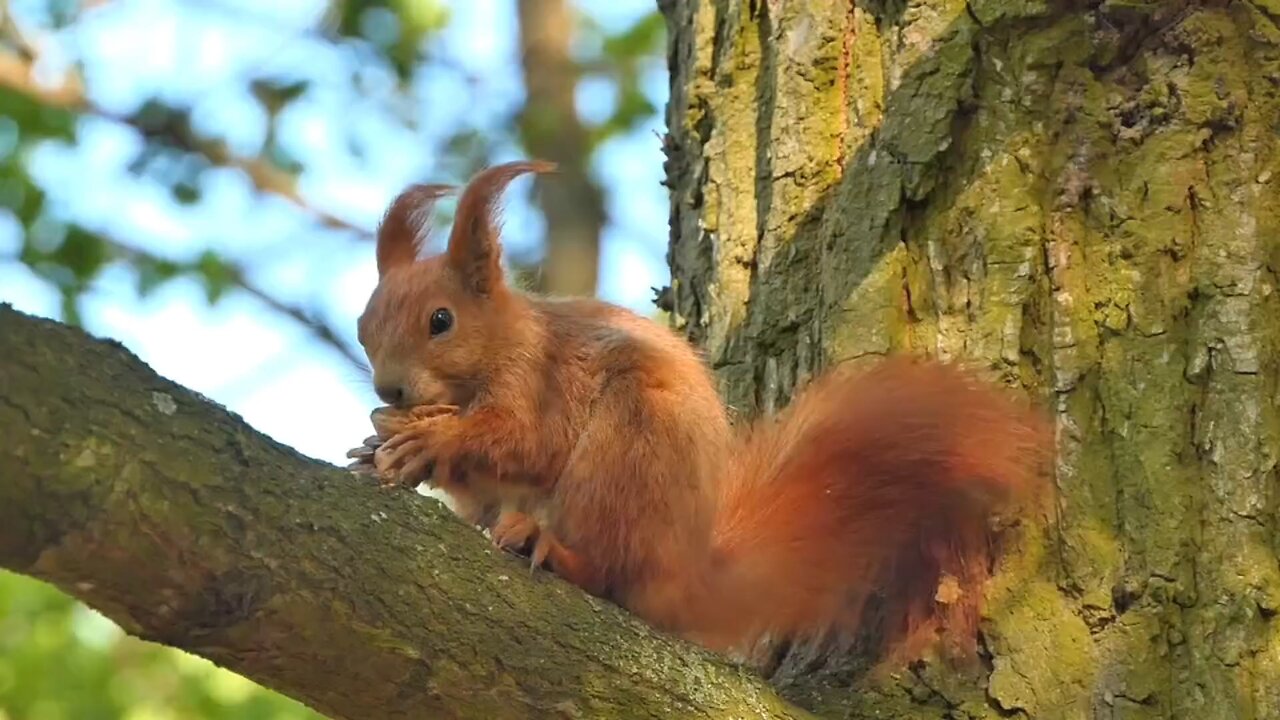Premium Only Content

"Squirrels: The Tiny Guardians of the Trees"
Squirrels are small to medium-sized rodents belonging to the family Sciuridae. They are widely recognized for their bushy tails, sharp claws, and lively behavior. Here's a detailed overview of squirrels:
### Physical Characteristics:
- **Size:** Squirrels vary in size depending on the species. Typically, they range from about 5 to 20 inches in body length, with tails adding another 4 to 12 inches.
- **Weight:** Most squirrels weigh between 0.5 to 1.5 pounds, though larger species, like the Indian giant squirrel, can weigh more.
- **Coat:** Squirrels usually have a thick fur coat that can be gray, brown, black, or red. Some species have distinctive markings or patterns.
- **Tail:** Their bushy tails serve multiple purposes, including balance, communication, and warmth.
### Species:
- **Tree Squirrels:** These are the most commonly recognized type of squirrel, often seen in parks and forests. Species include the Eastern gray squirrel, red squirrel, and fox squirrel.
- **Ground Squirrels:** Unlike tree squirrels, ground squirrels live in burrows. The California ground squirrel and the Arctic ground squirrel are notable examples.
- **Flying Squirrels:** These nocturnal squirrels have a membrane called the patagium that stretches between their limbs, allowing them to glide between trees. The Northern flying squirrel is a common species.
### Habitat:
- **Global Distribution:** Squirrels are found on almost every continent except Australia and Antarctica. They thrive in diverse habitats, including forests, woodlands, urban areas, and grasslands.
- **Nesting:** Tree squirrels often build nests, known as dreys, high in trees using twigs, leaves, and moss. Ground squirrels, on the other hand, dig extensive burrow systems.
### Behavior and Diet:
- **Activity:** Squirrels are mostly diurnal, meaning they are active during the day, with peak activity in the morning and late afternoon.
- **Foraging:** Squirrels are omnivores but primarily eat seeds, nuts, fruits, and vegetables. Some species also eat insects, bird eggs, and small animals.
- **Caching:** A common behavior among squirrels is caching, where they store food, like nuts, for later use. This behavior helps them survive when food is scarce, particularly in winter.
### Reproduction:
- **Breeding Seasons:** Squirrels typically breed once or twice a year, depending on the species and environmental conditions. The breeding season usually occurs in late winter and early spring.
- **Gestation and Offspring:** The gestation period lasts around 3 to 6 weeks. A female squirrel gives birth to a litter of 2 to 8 young, which are born blind and hairless. The mother cares for them in the nest until they are weaned and ready to venture out on their own.
### Communication and Intelligence:
- **Vocalizations:** Squirrels use a variety of sounds to communicate, including chattering, screeching, and barking. They also use tail movements and body language to convey messages.
- **Problem-Solving:** Squirrels are known for their intelligence and problem-solving abilities, particularly when it comes to accessing food sources, such as bird feeders.
### Predators and Threats:
- **Natural Predators:** Squirrels are preyed upon by a variety of animals, including hawks, owls, snakes, and domestic cats.
- **Human Interaction:** Squirrels often thrive in urban areas, but they can be considered pests when they raid bird feeders, chew on electrical wires, or nest in attics.
### Conservation Status:
- **General:** Most squirrel species are not endangered and are widespread. However, habitat loss and fragmentation can threaten some populations, particularly those of specialized or rare species.
- **Notable Species:** The red squirrel in the UK, for example, has seen declining numbers due to competition from the non-native Eastern gray squirrel.
### Interesting Facts:
- **Memory:** Squirrels have an excellent spatial memory, which helps them locate their food caches even months after hiding them.
- **Teeth:** Like all rodents, squirrels have continuously growing incisors that require regular gnawing to keep them from becoming too long.
Squirrels are adaptable, curious, and often entertaining animals that play important roles in their ecosystems, particularly in seed dispersal and forest regeneration.
-
 LIVE
LIVE
vivafrei
7 hours agoLive with Myron Gaines - from Global Politics to the "Manosphere" & Everything in Between
3,429 watching -
 LIVE
LIVE
Dr Disrespect
4 hours ago🔴LIVE - DR DISRESPECT - TRIPLE THREAT CHALLENGE - WZ, PUBG, FORTNITE
6,635 watching -

The Quartering
3 hours agoAdam Schiff IN TROUBLE, Woke Lefties MELTDOWN Over Temu, Karmelo Anthony Family LIES, & Much More
66K24 -
 LIVE
LIVE
RiftTV/Slightly Offensive
1 hour agoWho KILLED Virginia Giuffre? Only 11% of Black Chicago Students Can READ? | The Rift Report
724 watching -
 LIVE
LIVE
The HotSeat
50 minutes agoDeporting Illegals, Arresting Judges, and Saving Women's Sports — More, Please!
446 watching -
 25:18
25:18
Scary Mysteries
2 hours agoSTRANGE & SCARY Mysteries Of The Month - April 2025
191 -
 1:35:24
1:35:24
Russell Brand
4 hours agoEpstein’s Most Famous Accuser Found DEAD—Was She Silenced? – SF573
121K29 -
 1:49:00
1:49:00
Tucker Carlson
4 hours agoCatherine Fitts: Bankers vs. the West, Secret Underground Bases, and the Oncoming Extinction Event
87.7K66 -
 1:27:37
1:27:37
Sean Unpaved
3 hours agoPlayoff Fever, Draft Drama, MLB Thrillers & Belichick's Plus-One
30.9K1 -

Jeff Ahern
1 hour agoMonday Madness with Jeff Ahern (12pm Pacific)
4.34K1